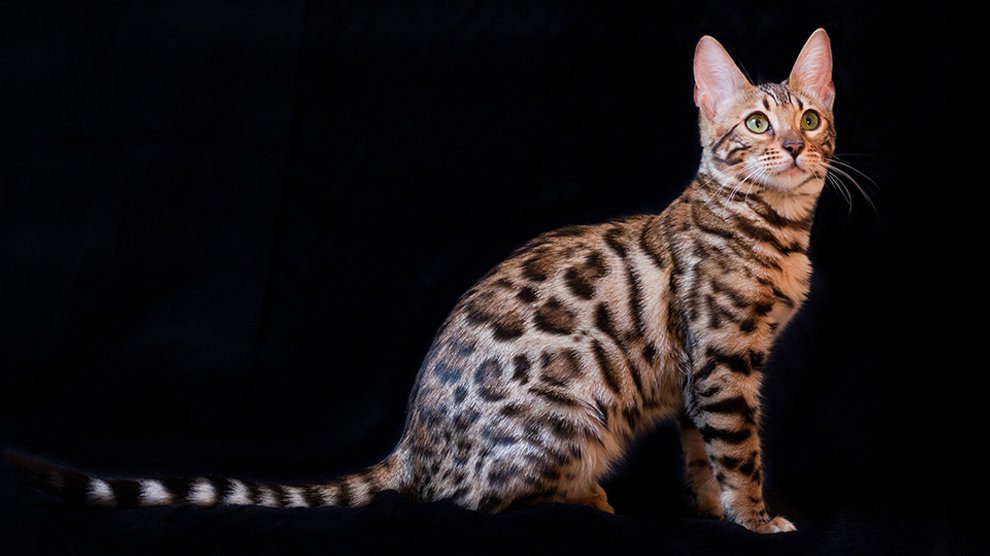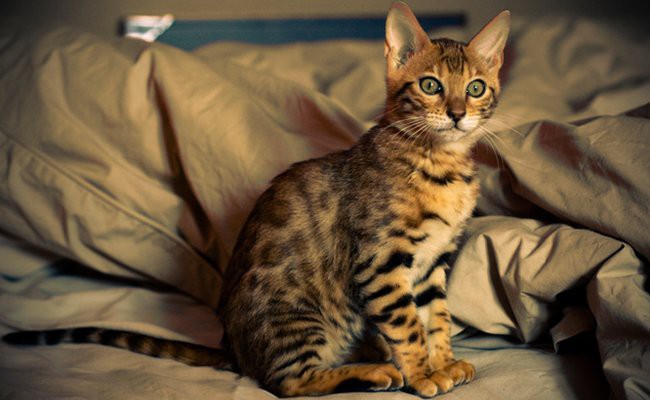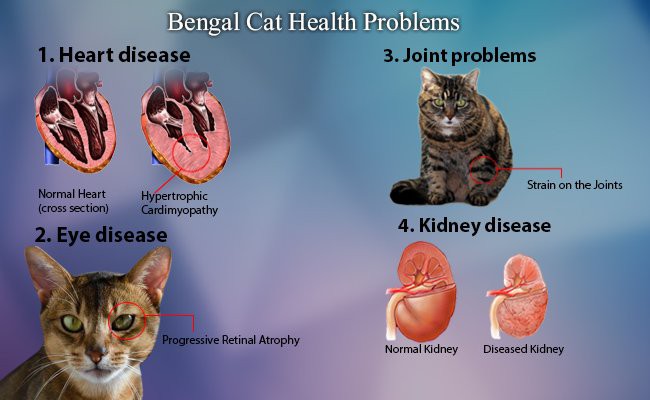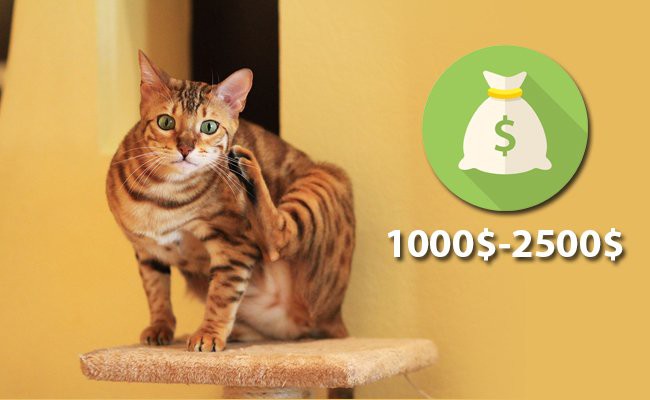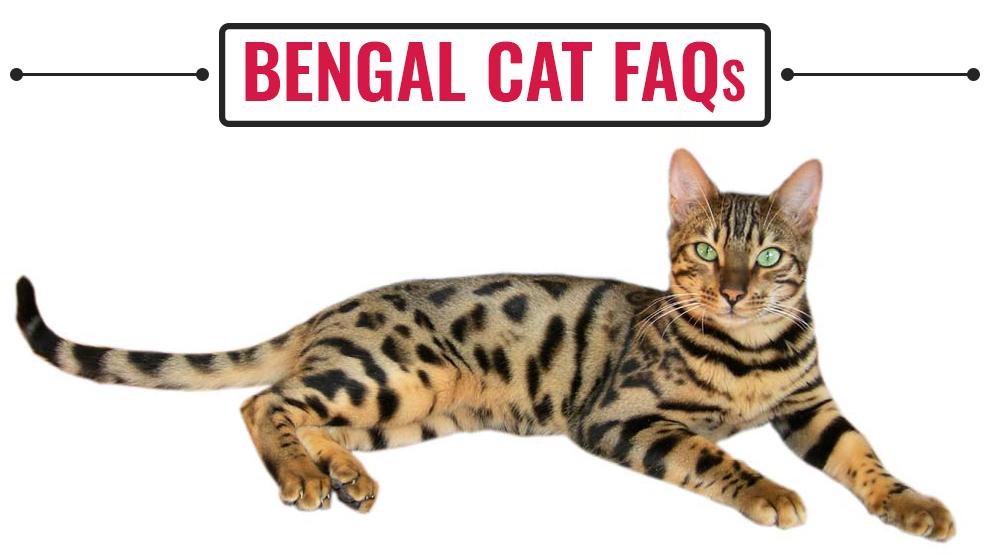Cat Pregnancy Calculator And Timeline
Bengal cats are lovely domestic animals known for their leopard-like markings and aggressive wild appearance. These exotic-looking cross-bred Bengal kittens were developed by selective breeding from hybrids of the Asian Leopard Cat (ALC), with the domestic cat.
The goal was to create a confident, healthy, and friendly cat with a highly contrasted and vividly marked coat.
Bengal Cats History
With its distinctive spotted coat and its large size, the Bengal cat looks like a wild cat on the prowl. Since one of their ancestors is the small, wild Asian leopard cat, they possess the characteristics of both feral and domestic cats.
Bengals (Bengal cats) take their name from the Asian leopard cat’s scientific name, Felis bengalensis. They were crossbred between an Asian leopard cat and a domestic cat in the 1950s. Only in the 1960s were they let to be purchased at pet stores.
Jean Mill, a breeder in California, was the first to make such a cross. The name Bengal cat comes from the taxonomic name Prionailurus bengalensis of the Asian leopard cat. Rugged appearance with rosettes or arrowheads or large spots is their trademark.
Their body structure resembles that of an ALC. The Bengal cats are strong, graceful, and agile athletes.

Bengal Cats Lifespan
Bengal cats typically have a lifespan of 12 to 16 years, although some can live longer with proper care and attention. Like all cats, the lifespan of a Bengal cat can be influenced by factors such as genetics, diet, exercise, and overall health.
To ensure your Bengal cat lives a long and healthy life, it’s important to provide them with regular veterinary care, a healthy diet, and plenty of exercises and mental stimulation. Regular checkups can help detect and treat any health issues early on, while a balanced diet and exercise can help prevent obesity and other health problems.
Additionally, providing your Bengal cat with plenty of mental stimulation and social interaction can help improve its overall well-being and happiness, which can contribute to a longer and healthier life.
Bengal Cat Size
At maturity, an average male Bengal breed cat weighs about 10 to 15 pounds and a female cat weighs about 8 to 10 pounds. Some adult male Bengals may weigh about 20 to 22 pounds, but this is abnormal.
These average weights are for healthy cats, not fat cats as they are naturally prominent.
Types Of Bengal Cats
- Light Golden Colored Bengal Cats
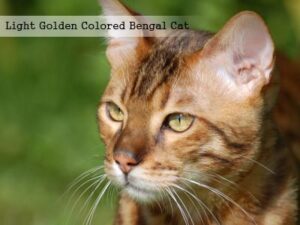
Black color patterns or chocolate brown color patterns appear on the light golden skin of the breed cat. The eye color of this type varies from yellow to green. Light Golden Colored Bengal Cats have black feet and their nose is brick red.
This Bengal breed cat’s tail is dark brown or black with light stripes ending in black.
- Dark Golden Colored Bengal Cats
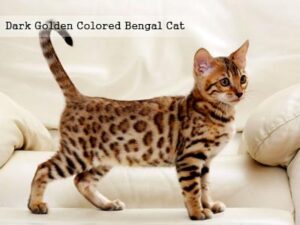
This breed cat variety can be identified by the presence of dark stripes of chocolate or black pattern on their dark gold-colored skin background. Dark golden-colored Bengal cats have a nose colored brick red and the fur around the mouth is white.
The light-colored spots on their belly look appealing. Their feet and tail are dark brown or black.
- Tri-Color Golden Colored Bengal Cats
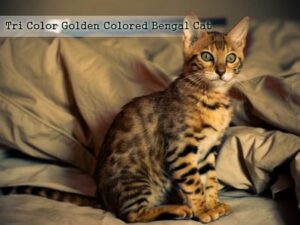
Brownish gold skin color with appearances of black patterns is evident. They have green or yellow color eyes and their ears are dark and ginger-colored.
Their belly is light golden colored with black spots and their nose is brick red. Their feet are always black.
- Cinamon-Sorrel Colored Bengal Cats
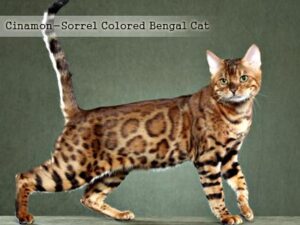
Dark ginger color patterns appear on light ginger or golden color skin backgrounds. They have a brick-red color nose with yellow or green eyes. Their belly is lighter with spots.
With dark ginger-colored tails ending in dark stripes, Cinamon-Sorrel-colored breed cats have dark brown feet.
- Grey Beige Colored Bengal Cats
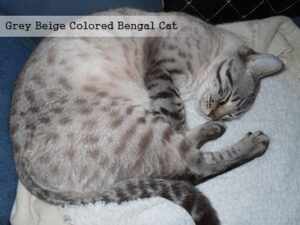
They have greyish beige skin color with dark brown or black patterns. Green or yellow-colored eyes are prominent. Brick a red colored nose with the edge of the mouth in black color.
The appearance of spots on the light-colored belly is evident. Their feet are black.
- Charcoal Colored Bengal Cats
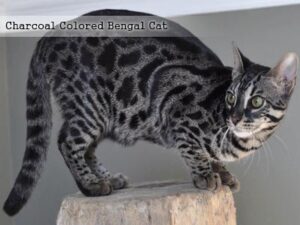
Dark greyish brown, greyish black or carbon-colored skin with appearances of dark patterns is visible on the fur. Green or yellow-colored eyes are evident. Their nose is brick des in color. Their feet are always black.
- Silver Colored Bengal Cats
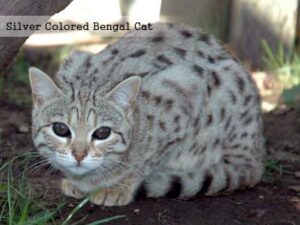
Silver-colored Bengal breed cat has silver-grey fur with patterns in black or dark grey which is eye-catching and nice. Their eye colors are greenish-grey or yellowish-grey. A dark silver striped tail with black feet is always seen on this type of Bengal.
- Blue Colored Bengal Cats
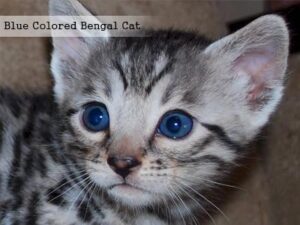
These Bengal cats have a light greyish blue or light blue colored skin with visible metal grey patterns on the fur. Blue Bengal breed cat is very rare to find and has a lot of demand among Bengal cats and kitten breeders.
- Black Colored Bengal Cats
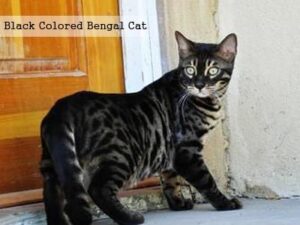
These are often referred to as black panthers because of the appearance of black patterns on the black background. Black-colored Bengals are less famous among the breeders because of the rarity of the breed.
They are often showcased in exhibitions due to the rate of increase in black Bengal admirers.
- Seal Sepia Colored Bengal Cats
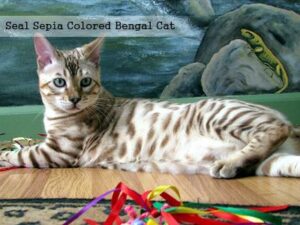
These are brown snow Bengal cats born with brown patterns with beige colored skin. Their base color becomes yellow with age along with their patterns which turn dark brown.
The eyes are either yellow or green and the color of the nose varies from brick red to brown. These cats have lightly-skinned bellies and their tail is black.
- Seal Lynx-Point Colored Snow Bengal Cats
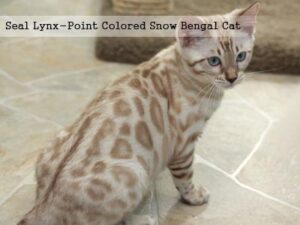
These are grey snow Bengals with a completely white background and very light brown patterns on them. Their color darkens with age which leads to light brown marks on the beige background.
One rare feature of this snow Bengal is the color of its eyes which are always blue. Their nose is brownish pink and their feet are always brown.
- Seal Mink Colored Snow Bengal Cats
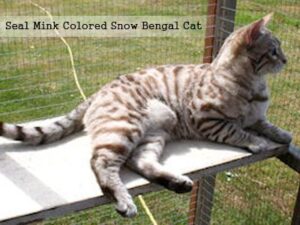
This snow Bengal is born with milk chocolate-colored patterns on a pale white background. The color also darkens with age just like the other snow Bengals. Seal mink snow Bengal cats have beautiful watery blue or greenish-blue color eyes.
Their nose is brownish pink and their feet are brown.
- Patterned Bengal cats:
Bengal cats are the most famous feline breed in the world. Irrespective of pattern or color, this type of cat is renowned for its outgoing personality. These cat varieties are playful and fearless.
The inquisitive nature of this cat makes it an ideal companion. Remember Bengal spotted cats have markings that are asymmetrical in nature and marbled Bengals also have them.
Different Patterned Bengal Cats Are
- Donut Rosette Patterned Bengal
- Cloud Rosette Patterned Bengal
- Paw Print Rosette Patterned Bengal
- Arrow Rosette Patterned Bengal
- Bengal Spotted Patterned
- Reduced Horizontal Flowing Marble Patterned Bengal
- Horizontal Flowing Marble Patterned Bengal
- Bull’s Eye Marble Patterned Bengal
- Closed or Sheet Marble Patterned Bengal
- Chaos Marble Patterned Bengal
Bengal Cat Personality
Bengal cats are talkative in nature as they try to communicate their needs and longings in the ways possible. They are highly territorial and demand large spaces just for themselves.
These breed cats are very selective about toileting and want their toileting tray to be spotless and clean each time.
They have a destructive nature which leads to damage to things at home such as wires, furniture, etc., Bengal cats require new toys often because they get bored quickly and also because they destroy their toys often.
These cats seek a lot of attention from their master and enjoy the attention they get. They are very friendly and loving by nature. This cat type is easy to train and is a quick learner.
They like getting wet and playing in the water, unlike the other cats that run at the sight of water.
They are excellent bird hunters. Bengal cats are food lovers and enjoy devouring their food.
Breeding Bengal Kittens
Male Cats are mostly infertile; however, some occasional male cats have the ability to reproduce. The female cats are all fertile.
They start breeding when they are one year old and retire from breeding when they are 4-8 years old depending upon the individual condition.
The Bengal kittens need no special care as they need the same care and attention as any domestic kitten requires.
Bengal Cats Diet
Though these are wild by nature, raw meat can cause food poisoning. Bengal cats love chicken so unseasoned cooked chicken meat is all that they want with their dry or soft food.
Their diet mainly consists of protein such as:
- Eggs
- Fish
- Chicken
- Meat
They also eat food containing:
- Rice
- Corn
- Soy
for carbohydrates
Bengal Cat Temperament
Are Bengal Cats Aggressive?
Bengal cats are no more aggressive than average domestic cats and are very loyal and friendly by nature.
These beautiful-looking cats are not well-behaved lap cats and misbehave a lot outside.
They hide anything they find attractive to them, right from expensive glittery jewels to important paper documents.
When they are bored or inactive, they start biting anything and everything that comes before them.
They want an entirely clean and spotless tray to defecate if their tray is not cleaned several times in 24 hours they find their own toileting place.
One has to hold the Bengal cats always busy to keep them from using their energy for negative activities.
Bengal cats are not for the inexperienced as they require high maintenance and an experienced caretaker.
Bengal Cat Health Problems
Heart disease
The heart condition Hypertrophic Cardio Myopathy (HCM) is common in Bengal cats. But these occur only in older cats. The heart muscle thickens, which makes the organ work much harder leading to numerous problems.
The disease also leads to congestive heart failure, resulting in death. Early signs of cardiomyopathy include panting and lethargy.
Eye disease
An eye condition Progressive Retinal Atrophy (PRA) causes the deterioration of the retinal’s rods and cones eventually causing blindness. Even young Bengal cats are prone to this disease as it is in their gene.
The Bengal cats may suffer from cataracts which may be removed through surgery by the Vet.
Joint problems
Joint pain occurs only in overweight Bengal cats because added weight puts more strain on the joints. Ensuring the cat stays at a good weight without getting fat would prevent the Bengal cat from getting joint problems.
Anesthetic allergies
Kidney disease
A kidney condition Chronic Renal Failure (CRF), is a common problem in older cats. The most noticeable symptom is an increase in water consumption and urination. There are several conditions that can cause this disease.
The symptoms of kidney failure are not seen until approximately 75% of kidney tissue is non-functional. Kidney failure is the most common cause of death in older cats. Long-term feeding of an all-dry-food diet will result in Chronic Renal Failure.
Chronic kidney failure is progressive and incurable. No conventional or alternative medical treatment can reverse its course since the disease involves the loss of kidney cells and replacement by scar tissue.
Price For Bengal Cats
The price for a Bengal cat can vary widely depending on a number of factors, including the cat’s age, lineage, coat pattern, and overall health.
In general, you can expect to pay anywhere from $500 to $3,000 or more for a Bengal cat.
Bengal kittens from reputable breeders typically start at around $1,000 to $2,000, while adult Bengal cats can range from $500 to $5,000 or more depending on their pedigree and breeding history.
Factors such as the cat’s coat color and pattern can also affect the price, with rare and highly sought-after coat patterns commanding a higher price.
Bengal Cats Breeders
1) Hooves and Paws Animal Rescue
Address:
PO Box 1469
Littlerock, CA 93543
2) Greenwood County Animal Shelter/Adoption Center
Address:
235 Wilbanks Circle
Greenwood, SC 29649
3) Nina Mason Pulliam Campus for Compassion
Address:
1521 W. Dobbins Road
Phoenix, AZ 85041
4) Great Lakes Bengal Rescue
Address:
10720 Hite Creek Rd
Louisville, KY 40241
Bengal Cats Adoption
If you’re considering adopting a Bengal cat, there are several things you should keep in mind.
First, it’s important to find a reputable breeder or rescue organization that specializes in Bengal cats.
Look for breeders who are registered with a recognized cat association and have a good reputation in the cat community. You can also consider adopting a Bengal cat from a local shelter or rescue group.
When adopting a Bengal cat, be prepared for its high energy level and need for mental stimulation.
They require plenty of exercise and playtime, so make sure you have enough space for them to run and play, and provide plenty of interactive toys and games.

